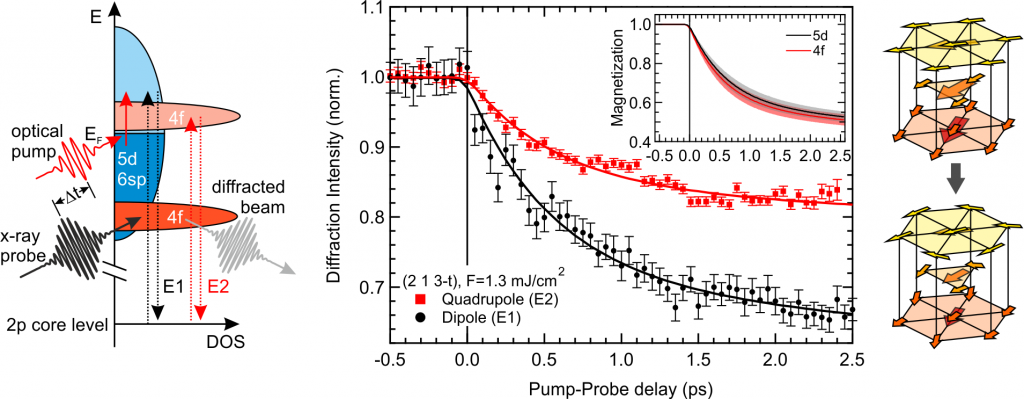Antiferromagnets (AF) have attracted great interest in recent years due to their self-cancelling spin arrangement with zero net moment, rendering them largely insensitive to external fields. Such stability holds great potential for devices (e.g. for digital storage density and longevity), but also poses significant challenges to implement magnetic functionality, requiring new approaches to interact with magnetic order. Another potential benefit of AF spintronics stems from their enhanced magnetic resonance frequencies, promising efficient control of the magnetic state by ultrashort pulses. In our group, we employ time-resolved resonant x-ray diffraction to acquire quantitative information about the ultrafast dynamics of this fascinating ordered magnetic state.
Itinerant and Localized Magnetization Dynamics in Antiferromagnetic Ho
The exchange interaction between different magnetic moments is the dominating force determining spin ordering in magnetic materials. In particular the interplay of itinerant d-electron and localized f-electron magnetic moments in 4f metals and their alloys opens up new routes to control their magnetic behavior on ultrafast timescales. In a study performed at the LCLS free electron laser, we used femtosecond time-resolved resonant magnetic x-ray diffraction at the Ho L3 absorption edge to investigate the demagnetization dynamics in antiferromagnetically ordered metallic Ho after femtosecond optical excitation. By tuning the x-ray energy to the electric dipole (E1) or quadrupole (E2) transition we investigated selectively and independently the spin dynamics of the itinerant 5d and localized 4f electronic subsystems. The simultaneous demagnetization of both subsystems demonstrates strong intra-atomic 4f-5d exchange coupling. The demagnetization time scales which are very similar to ferromagnetic 4f systems, suggest that the loss of magnetic order occurs via a similar spin-flip process in both cases.

Publications
- S.-E. Lee, Y. W. Windsor, A. Fedorov, K. Kliemt, C. Krellner, C. Schüßler-Langeheine, N. Pontius, M. Wolf, U. Atxitia, D. V. Vyalikh, L. Rettig
Robust magnetic order upon ultrafast excitation of an antiferromagnet
Adv. Mater. Interfaces 2201340 (2022)
- Y. W. Windsor, S-E. Lee, D. Zahn, V. Borisov, D. Thonig, K. Kliemt, A. Ernst, C. Schüßler-Langeheine, N. Pontius, U. Staub, C. Krellner, D. V. Vyalikh, O. Eriksson, L. Rettig
Exchange scaling of ultrafast angular momentum transfer in 4f antiferromagnets
Nat. Mater. 21, 514 (2022)
- Y. W. Windsor, A. Ernst, K. Kummer, K. Kliemt, Ch. Schüßler-Langeheine, N. Pontius, U. Staub, E. V. Chulkov, C. Krellner, D. V. Vyalikh, L. Rettig
Deterministic control of an antiferromagnetic spin arrangement using ultrafast optical excitation
Commun. Phys. 3, 139 (2020)
- L. Rettig, C. Dornes, N. Thielemann-Kühn, N. Pontius, H. Zabel, D. L. Schlagel, T. A. Lograsso, M. Chollet, A. Robert, M. Sikorski, S. Song, J. M. Glownia, C. Schüßler-Langeheine, S. L. Johnson and U. Staub
Itinerant and Localized Magnetization Dynamics in Antiferromagnetic Ho
Phys. Rev. Lett. 116, 257202 (2016)